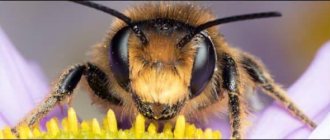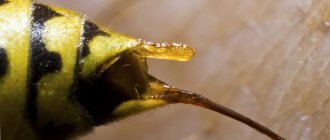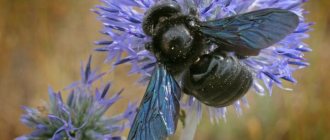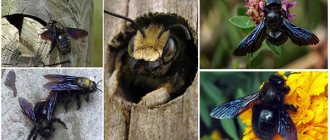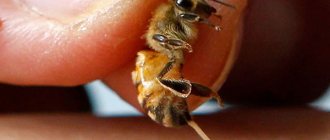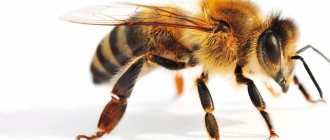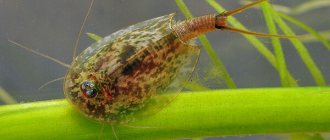Man has been engaged in beekeeping for several thousand years and, it would seem, everything is already known about striped workers. However, there are species of insects that are similar in body structure to the bees we are used to, but have radically different colors. These are the so-called earth bees, or Andrenes, - the largest genus of bees, numbering more than 1,500 species and found everywhere.
The distinctive features of these insects, relative to the bees familiar to us, are:
- Insects, in most cases, build their homes in the ground rather than nesting in tree holes or beehives. In fact, that’s where they got their name from;
- Andrenes do not live in large colonies; they prefer to settle next to each other, but each builds its own house.
These bees are an important part of the ecosystem and are involved in the pollination of flowering and agricultural plants and crops, along with other pollinating insects.
Kinds
Scientists have studied the varieties of earth bees and identified several communities, the most famous being the following:
- Andrena clarkella looks like a small fluffy bumblebee with long red legs. Males of this breed do not have a bright color, they are thin, their body is elongated;
- Andrena magna: not a common subspecies, settles in the Black Sea region, externally, individuals are characterized by the presence of thick fur;
- Galikt sphecodes: a metallic red-green bee that looks a bit like a wasp and is found throughout the world;
- The long-moustached variety is the owner of a pronounced mustache on a relatively small head;
- Woolbite: a small, bright representative of the genus, mainly living in the bark of bushes and trees or in abandoned holes, since it does not dig them;
- The leafcutter (megachilus) got its name because it lines its nest with leaves and lives only for two months, giving way to its offspring;
- The nomad (cuckoo) does not have the ability to arrange its own nest, so it lays its larvae in other people’s nests;
- Mellitid is characterized by a selective approach to plants, pollinating only legumes and asteraceae;
- Carpenter: a solitary subspecies characterized by a bluish tint and a loud buzzing sound.
The listed representatives: this is only a small studied part of the range of arthropods living in the underground.
Chemical methods
The most effective method of getting rid of earth bee colonies is considered to be fumigation using a special smoker. In this case, 100% death of all pests is ensured.
You need to purchase a special poisonous substance to kill wild bees and do not hesitate to add as much of this poison as possible, since an insufficient amount will not kill the insects, but will make them aggressive, which will lead to an attack on people.
You can use the “Get” product to get rid of wild wasps. This toxic substance contains 5% chlorpyrifos, which is enough to treat one hundred square meters of land.
“Get” is an effective remedy for wasps and hornets
So, instructions for working with the fumigator and chemical agent:
- Dress in a protective suit, don’t forget the net and thick gloves;
- Using a smoker, fumigate the area where earth bees gather. After this, the insects will become lethargic and inactive;
- Now you need to carefully introduce the chemical into the earthen holes - nests. Don’t be afraid to overdo it, the more poison, the better the result;
- Having finished the job, tightly close the passages to the underground hives.
The next morning, dig up this piece of land and plant lavender or lemon balm on it. Insects, especially bees, do not like the smells of these plants, and they will fly around your area.
Video: Earth bees
The basis of the arthropod family is traditionally the queen, who is the first to find a suitable burrow and lay larvae in it for the birth of new individuals. As they develop, they begin to collect pollen and deposit it in vessels from the ground previously strengthened with saliva. The uterus, having given birth to offspring, dies.
The material for creating their own housing is soil, from which bees create deep burrows. They represent a city, it has a lot of branches and passages. But not only the earth attracts bees to build housing; they often settle in the bark of trees or in the cracks of the walls of a wooden house. Housing for hymenoptera is often a leaf of a tree or a crevice in a rock.
The earth is also the basis for breeding: the burrow is lined with a waterproof layer consisting of saliva, soil and secretion produced by the abdominal glands. In this durable substance, arthropods store larvae, from which their brothers emerge. A new burrow, where the next generation will be born in the future, is created only after the previous one appears.
Environment and habitat features
Wild bees live in colonies in a hive hidden from us, consisting of hundreds of passages. The walls of the “corridors” are strengthened by mixing soil with saliva. Females collect nectar to create a nutritional cushion for future offspring. After 14 days of laying the eggs, the “children” contribute to the construction of the underground hive. There are species that live in small families, as well as solitary ones.
The habitat of ground wasps is soil or its surface, quiet corners with a good food supply. Often for the wasp family, living on the ground is a forced temporary measure caused by unfavorable conditions. Offspring can easily change their place of residence to a hollow tree or a crack in the wall.
Role in nature: benefits and harm
Bee communities: They are an integral part of nature that benefits it by pollinating different plants, thus maintaining the natural balance. They are bred specifically for pollinating gardens; bees living in the ground are a real find for lovers of flower plants.
However, individuals can cause harm to both humans and natural areas. The sting of such a bee is dangerous; it threatens with unpredictable consequences associated with allergic manifestations.
They also damage lands with their huge corridors of cells. Urbanization is gradually leading to the disappearance of places where associations of arthropods quietly carry out their normal activities. Therefore, they gradually move to dachas and gardens, bite their owners, destroy beds, spoil garden plots: they cause serious damage.
The best time to fight the conquerors: the end of the winter period. During this period, they are not yet active enough and are too scattered, so a minimum of forces will be needed to destroy them. During the period of active activities associated with the use of hazardous substances, it is necessary to remove household members and animals from the site.
General information about insects
An ordinary earth bee is a large and bright insect, its wings are purple or yellow-brown, the body itself is black, and the head and legs are bright red. The size of the average individual reaches 18 -20 mm.
For settlements, bees choose soil with a high sand content. Usually they are grouped into large families, the grown-up offspring settle nearby, so the settlement area is constantly increasing.
For settlements, bees choose soil with a high sand content
The tunnels go deep into the ground because these bees are excellent builders and hard workers. It is believed that such insects do not attack people and animals unless absolutely necessary, but there are periods when all insects, without exception, are particularly aggressive. And if you disturb them or destroy their home, then nothing will protect them from attack.
The ground bee does not attack people or animals unless absolutely necessary.
Bee tunnels have oval rooms on the sides, which are used for breeding and storing nectar. In these enclosed spaces, the resulting nectar does not leak out and is perfectly preserved even for years. The walls of these rooms have waterproof properties, which requires extremely painstaking work by insects.
Burrow of earth bees
Honey extraction
Andrena magna produces dark yellow nectar that maintains its healing properties for a long period. The design of dead-end burrows that bees constantly create allows this product to be placed in them. It is perfectly preserved in natural containers due to the fact that females and males work tirelessly, strengthening the loose soil with their saliva.
Honey production is no different from the well-known process. Bees living in tunnels, like their domesticated relatives, are very hardworking and excellent at pollinating flowers and plants. After collecting the nectar, its natural fermentation occurs, then the product is placed in honeycombs and waits for its ripening time. Nectar cells do not always have an exact hexagonal shape, but take the shape of a circle, oval or square.
The honey of these bees is very similar to the usual farm product, its careful extraction will not harm the individuals. To do this, the tunnels are slightly torn and a small amount of nectar is taken, leaving part of it for the inhabitants of the dungeons so that they do not die from hunger in the future and can restore their family.
What they look like
Most species of wild bees are very similar to honey bees, which we often see in apiaries. However, there is such a variety of these insects on the planet that it is simply impossible to make any definite description of their appearance. Of all the existing species of bees on earth, 80% are classified as earth bees.
Despite such diversity, you can distinguish a bee from an apiary from an earthen bee by the following characteristics:
- on average, the body length ranges from 8 to 17 mm (males and females differ little in size);
- the wings are slightly curved, the basal vein is almost straight;
- the color can be varied: black, blue, green, silver, etc.;
- females have a swivel tassel on their hind legs.
Video: Collecting honey from wild earth bees
Unfortunately, there are many who like to feast on free nectar without knowing the limits. This leads to the barbaric destruction of burrows, the destruction of honeycombs that took so long to create and an imbalance in nature. Experts recommend that there is no need and there is no threat to people purchasing a home product in a civilized way.
Experts highlight the qualities of honey: it is useful for colds, gastrointestinal problems and inflammatory processes. According to some indicators, it is considered a better product than traditional honey.
Insect control methods
You need to start fighting these insects as soon as they are discovered. Of course, it is best to seek help from professionals. There are special companies that specialize in combating any pests.
But if for some reason you cannot turn to professionals, then you will have to solve this problem yourself. Before you start work, you need to familiarize yourself with some rules and be sure to protect yourself from all possible consequences.
Danger to humans
Insects pose a danger to humans primarily due to their unpredictability; they sometimes attack him for no apparent reason. Often the attack is caused by only one reason: the desire of people to get their honey.
The venom released by bees contains histamine. When bitten, this substance can immediately cause swelling and muscle spasms.
The first thing you need to do if you are bitten by a bee is to quickly remove the sting and treat the area where it hit with an antihistamine. This is especially important if the person attacked by individuals is allergic. People prone to allergic reactions are advised to have a blockade in the form of a syringe with medications on hand.
If such a drug is not available, it is better to apply a cool compress with added sugar to the bite site. If the victim has already experienced the effects of allergies or has been bitten too many times, and some of them were on the lips or tongue, you should immediately consult a doctor. Cases of death after earth bee stings have not been recorded, but anaphylactic shock cannot be ruled out.
What to do if you are bitten
Bees are usually not aggressive and will bite people. But if you accidentally damage their home, then for the purpose of protection they can attack a person and sting.
In such cases, a number of measures should be taken:
- The bite site should be treated with an alcohol solution
- Be sure to remove the sting from soft tissues using tweezers
- Take anti-allergy medications.
- Apply cold to the bite site.
- If swelling, shortness of breath increases, body temperature rises, or breathing becomes difficult, you should immediately go to the hospital or call an ambulance.
Is it necessary to fight earthly inhabitants?
The fight against the population must begin with finding the shelter where it has settled, otherwise all efforts will be in vain. Next, experts advise using one of the effective methods of destroying the bee community:
- Fill the settlement with boiling water, taking into account that you will need a lot of water, since you will have to fill all the passages. If one or two bees survive, they can start a colony again;
- digging up the soil will be an effective method if the tunnels of the underground inhabitants are not located too deep and it is impossible to reach them with a shovel. During digging, you must wear a mask and protective suit;
- installing traps - bottles with syrup, into which the Hymenoptera will fall as soon as they fly out of the nest, is considered a simple and safe method;
- chemicals: for example, Dichlorvos and Delta Zone: popular products, they allow you to get rid of bee clusters with almost one hundred percent certainty. Before chemical treatment, smoke is released into the tunnels, which significantly reduces their activity.
Experts recommend preventing the spread of underground insects on the site in advance. There are several simple ways to do this: do not plant flowers in flower beds that emit too strong a smell or plant lavender, the aroma of the flower repels hymenoptera. On the contrary, if celery, parsley and sunflower grow in the garden, then bees can become frequent guests of garden plots.
Removal
How to get rid of earth bees on your property yourself? The most common methods of combating stinging insects in the country are as follows:
- Filling with boiling water.
- Setting traps.
- Use of pesticides.
- Destruction by digging.
- Planting repellent plants.
- Call a pest control service to remove pests.
Whatever method you choose, it is important to remember the following safety precautions:
- There should be no strangers, children, or pets on the territory;
- Doors and windows to the house and outbuildings must be tightly closed;
- Wear clothing to protect your skin from bites, prepare escape routes and everything you need in advance;
- Any treatment should be carried out in the evening, in cold weather, when the insects are sleepy and sit out in the hive.
Water
Filling tunnels with boiling water is a very popular effective method for killing earth bees. Take 15-20 liters of boiling water and fill all visible holes as quickly as possible. This makes it impossible for individuals to emerge from underground shelters, but injures the root system of the plantings.
Traps
Prepare several bottles, pour water with plenty of sugar inside. Buzzing neighbors will not be able to resist the smell of sweet syrup and will end up inside the bottle, from where they will no longer be able to get out.
Plants
Do bees come to you from your neighbors' garden? The owners behind the fence don’t want to destroy earth bees? How to protect yourself from annoying stinging creatures? A high fence will help - pollinators fly at a height of up to one and a half meters, and therefore a three-meter polycarbonate fence would completely solve the problem.
However, this is a very expensive and troublesome pleasure, so repellent plants with a pronounced odor can help you: lavender, mint, wormwood, lemon balm. Spraying insects' favorite places with a decoction of lemon or orange peel is effective - forums for summer residents claim that bites will occur less frequently.
Digging
If the takeover of an area by an aspen or bee family has just begun, the tunnels are not deep, you can try digging up the ground. You need to dig until honey is discovered - it is hidden in the lower part of the home.
If the swarm settled long ago, it will not be possible to get to the lower floors. Don't forget to wear a protective suit, because angry insects will fight for their hive.
Chemicals
To reduce the activity of insects, it is first recommended to smoke the nests, then proceed to spraying and filling the minks with a toxic substance. After this, the passages must be filled up so that the surviving individuals do not get out.
What drugs are suitable for killing earth bees in this way? Most often on the forums of summer residents they recommend Dichlorvos, Get, DeltaZone. These insecticides are sold at any hardware store.
Despite the apparent simplicity of using poisons, remember: poisoning of fertile soil, loss of crops, and poisoning by toxic fumes is possible. Do not forget to protect your skin and respiratory organs, strictly follow the instructions.
To destroy earthen wasps, Karbofos, Aktara, Solfisan, Kukaracha, Troapsil, Tsimbush and other contact insecticides in combination with boric acid are used. To destroy wasp nests in the ground at their summer cottage, desperate gardeners fill the tunnels with kerosene and then set them on fire. Needless to say, this method of struggle is unsafe?
Pest control services
There are too many ground bees, but your attempts to get rid of this problem on your own have not been successful? Call professional exterminators. An experienced specialist will not miss a single nest, and will also select the correct insecticide and its dosage depending on the characteristics of the soil, the structure of the tunnels, and the number of pests.
Disinsection service employees will carry out treatment in a few hours to completely destroy earthen wasps on the site, using effective means and equipment that are not available to the average person.
Where do they live and how do they live?
Insects are common in almost all regions of the earth with the exception of:
There are more than 400 species of earth bees on the European continent alone.
Most of them prefer to nest in sandy or loose sandy loam soil, digging peculiar tunnels up to 80 cm deep. That is why small nests can be found in flower beds or front gardens. However, these insects can set up their homes in other places:
- in rock cavities;
- in the interbrick space of walls, they can be especially often found in old buildings;
- in the stems of some plants.
Most species prefer to live in small colonies. The young do not fly far from their relatives and dig their own burrows nearby. But there are species that prefer a solitary existence. These include, for example, carpenter bees and leaf cutter bees.
To organize their home, bees can use soil, stones, leaves and other materials of both natural and artificial origin. For example, various small debris left over from human activity.
The insects dig a small tunnel at the end of which they make a special extension used for storing honey and laying eggs. The space is strengthened by its own saliva, which protects the home from collapse. After the younger generation grows up, the queen, as a rule, dies.
Emergency first aid for a bee sting
What to do at home if you are bitten by a bee and the victim shows all the signs of a severe reaction to insect toxins?
In this situation, you cannot hesitate. Immediately after calling doctors, a person who has suffered from bee stings needs to be provided with peace and warmth. To reduce the risk of edema, the patient is given an injection of antihistamines. In addition, it is important not to leave the person alone and at the same time control:
- heart rate;
- blood pressure indicators;
- the functioning of the respiratory system and the condition of the mucous membranes.
First aid after a bee sting may include emergency ventilation. Indirect cardiac massage and mouth-to-nose artificial respiration may be necessary.
